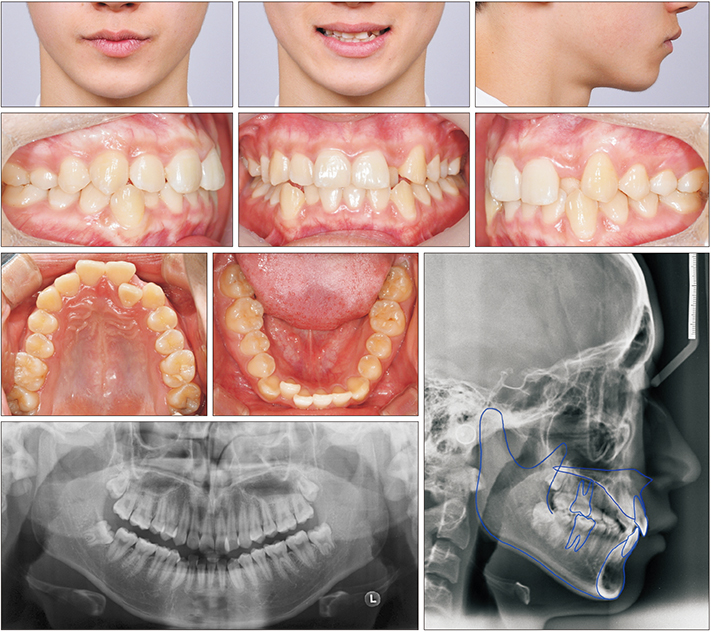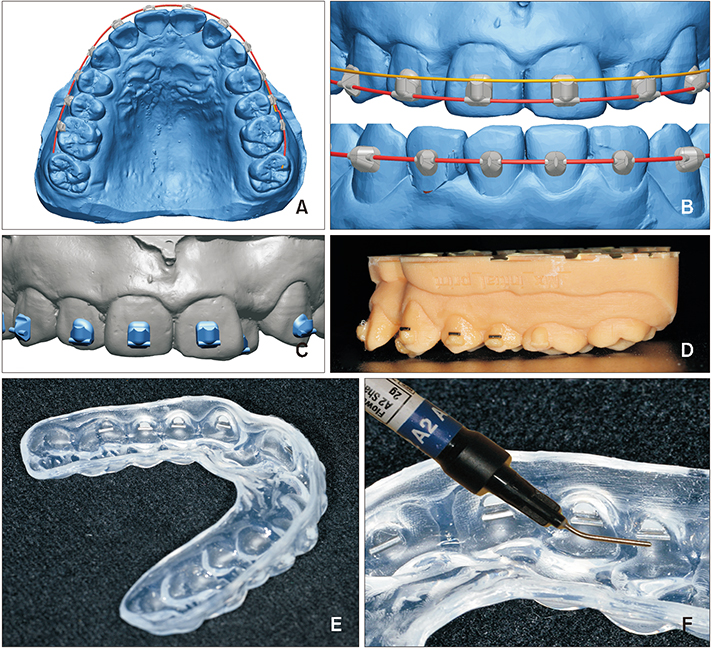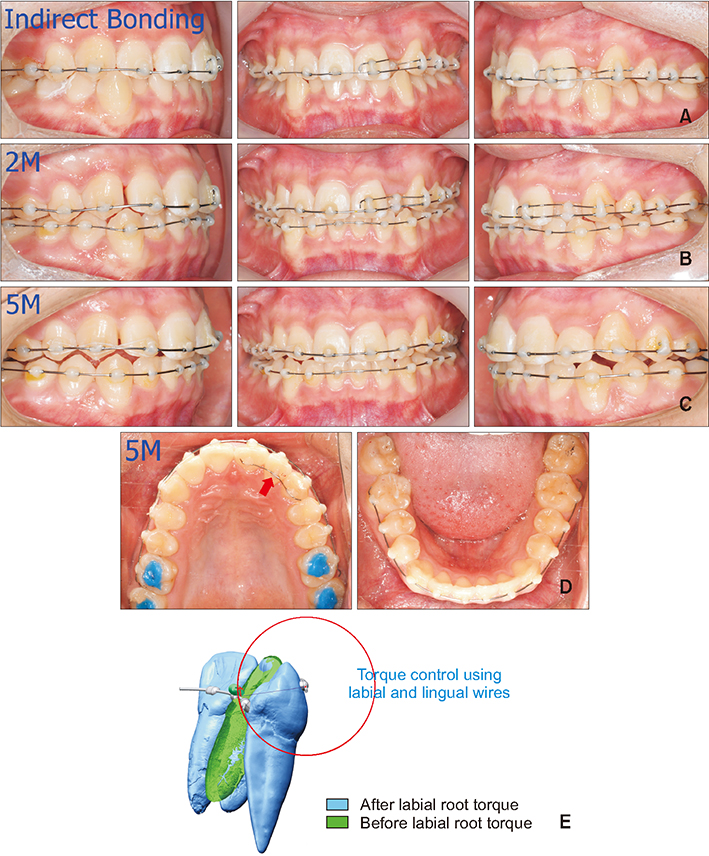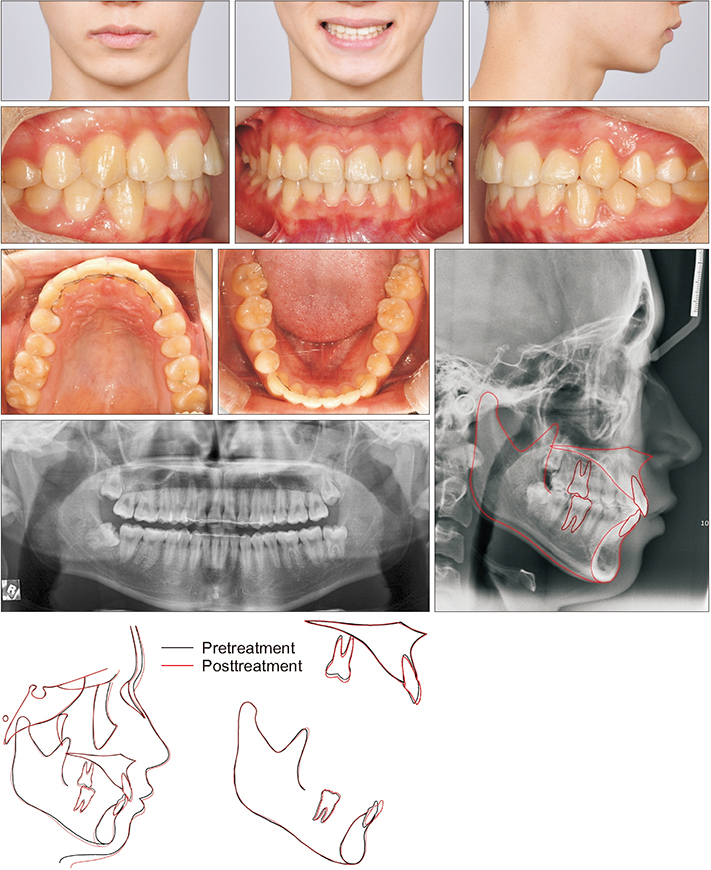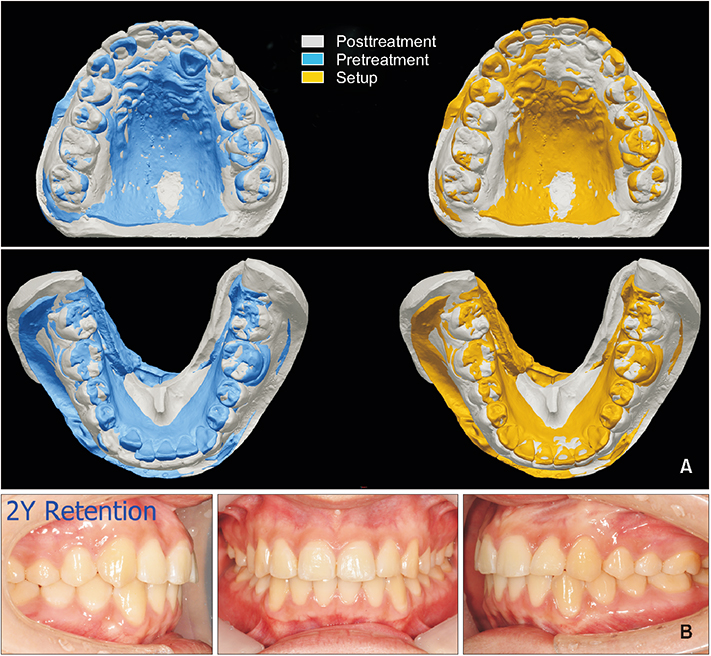Korean J Orthod.
2019 Mar;49(2):116-123. 10.4041/kjod.2019.49.2.116.
Treatment of Class I crowding using simple tubes bonded with customized resin coverings: A case report
- Affiliations
-
- 1Department of Orthodontics, College of Dentistry, Chosun University, Gwangju, Korea. shlim@chosun.ac.kr
- KMID: 2453975
- DOI: http://doi.org/10.4041/kjod.2019.49.2.116
Abstract
- As an alternative to the conventional fixed appliance that uses orthodontic brackets, a simple round tube without a bonding base can be bonded to the tooth surface by covering the tube with flowable resin. In this technique, bent wires cannot be inserted into the simple tubes; therefore, repositioning of the simple tubes is often required for adjustments. To reduce repositioning of simple tubes, a dome-shaped resin covering of the simple tube can be designed with a customized in-and-out compensation, using three-dimensional computer-aided design software based on digital simulation of orthodontic tooth movement. In the present case, the use of simple tubes bonded with customized resin coverings in a Class I nonextraction case is described in a 17-year-old male, in whom moderate crowding of the anterior teeth was treated over an 8-month period. This case shows that simple tubes can be used as an alternative to brackets in some Class I nonextraction cases, with the potential benefit of reducing decalcification.
Keyword
MeSH Terms
Figure
Reference
-
1. Liou EJ, Chen LI, Huang CS. Nickel-titanium mandibular bonded lingual 3-3 retainer: for permanent retention and solving relapse of mandibular anterior crowding. Am J Orthod Dentofacial Orthop. 2001; 119:443–449.
Article2. Park SH, Lee YK, Chun YS. Correction of palatally displaced maxillary lateral incisors using a tube system. J Clin Orthod. 2008; 42:461–465. quiz 455-6.3. Choi KH, Lee Y, Kim M, Chun YS. Correction of palatally displaced maxillary lateral incisors without brackets. Korean J Orthod. 2013; 43:201–206.
Article4. Kim M, Kim M, Chun YS. Molar uprighting by a nickel-titanium spring based on a setup model. Am J Orthod Dentofacial Orthop. 2014; 146:119–123.
Article5. Jung JM, Wi YJ, Koo HM, Kim MJ, Chun YS. Maxillary molar derotation and distalization by using a nickel-titanium wire fabricated on a setup model. Korean J Orthod. 2017; 47:268–274.
Article6. Musilli M. The Bracketless Fixed Orthodontics: nine years of clinical experimentation. Prog Orthod. 2008; 9:72–92.7. Musilli M, Acanfora M, Gherlone E, Lucchese A. Anterior torque correction with bracketless fixed orthodontics. J Clin Orthod. 2012; 46:558–562. quiz 581-2.8. Mariniello A, Cozzolino F. Atlas of bracketless fixed lingual orthodontics: basic concepts. Milan: Quintessence Publishing;2015.9. Kim TK. Bracket-free orthodontics. Seoul: Daehan Narae Publishing;2015.10. Hwang HS, Jeon HR, Kim SP, Kim WS, Lee GH. A new orthodontic appliance for rapid anterior alignment in adults; mini-tube appliance (MTA). J Korean Dent Assoc. 2011; 49:398–409.11. Zhu P, Lin H, Han Y, Lin Y, Xu Y, Zhang Z. A computational fluid dynamic analysis of peri-bracket salivary flow influencing the microbial and periodontal parameters. PLoS One. 2013; 8:e62242.
Article12. Roh YY, Lim SH, Jeong SR. Orthodontic correction of bialveolar protrusion by interproximal reproximation and water-soluble tubes bonded with deflection-based bonding technique: a case report. J Korean Dent Assoc. 2017; 55:850–860.13. Jang I, Tanaka M, Koga Y, Iijima S, Yozgatian JH, Cha BK, et al. A novel method for the assessment of three-dimensional tooth movement during orthodontic treatment. Angle Orthod. 2009; 79:447–453.
Article14. Macchi A, Tagliabue A, Levrini L, Trezzi G. Philippe self-ligating lingual brackets. J Clin Orthod. 2002; 36:42–45.15. Macchi A, Norcini A, Cacciafesta V, Dolci F. The use of bidimensional brackets in lingual orthodontics: new horizons in the treatment of adult patients. Orthodontics. 2004; 1:21–32.16. Lim SH. Digital fabrication and application of clear aligner after alignment with NiTi archwires. J Korean Dent Assoc. 2016; 54:551–562.17. Rossini G, Parrini S, Castroflorio T, Deregibus A, Debernardi CL. Efficacy of clear aligners in controlling orthodontic tooth movement: a systematic review. Angle Orthod. 2015; 85:881–889.
Article18. Kim JY, Yu WJ, Koteswaracc PNK, Kyung HM. Effects of bracket slot size during en-masse retraction of the six maxillary anterior teeth using an induction-heating typodont simulation system. Korean J Orthod. 2017; 47:158–166.
Article
- Full Text Links
- Actions
-
Cited
- CITED
-
- Close
- Share
- Similar articles
-
- Clinical perspectives on 2-unit cantilevered resin-bonded fixed partial denture
- Resin bonded fixed prosthesis for single tooth restoration: A case report
- Upper and lower second premolar extraction treatment case: Treatment strategy for Class III borderline cases
- Effect of thermocycling on shear bond strength and mode of failure of bonded retainer using flowable composite resin
- Resin-bonded fixed partial denture using In-Ceram and Targis-Ventris system

